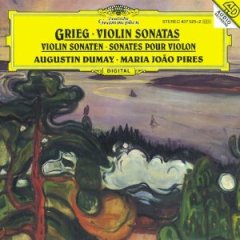Edvard Grieg – Violin Sonatas
Grieg - Violin Sonatas (Dumay)

1. Sonata F-Dur Op. 8, I. Allegro Con Brio 2. Ii. Allegretto Quasi Andantino, PiÙ Vivo, Tempo I 3. Iii. Allegro Molto Vivace 4. Sonata G-Dur Op. 13, I. Lento Doloroso, Poco Allegro, Allegro Vivace 5. Ii. Allegretto Tranquillo 6. Iii. Allegro Animato 7. Sonata C-Moll Op. 45, I. Allegro Molto Ed Appassionato 8. Ii. Allegretto Espressivo Alla Romanza, Allegretto Molto, Tempo I 9. Iii. Allegro Animato Augustin Dumay – violin Maria João Pires – piano
Structural weakness precluded Grieg's violin sonatas from being regarded as masterpieces. For instance, contrasting themes often jump from one to another without smooth transition. Yet it would be a most remorseful thing to dismiss these pieces as second-rate or mediocre, for they are among the most palatable dishes of violin music. The enchanting melodies are all of captivating beauty, and the essentially light-hearted music is in turn passionate, expressive, bittersweet, exuberant, and vigorous.
Dumay's soft-grained, pliant, colorful and multi-dimensional tone is ideally suited to these delectable pieces, and his Gallic style is most charming. Unlike some Soviet interpreters, he gave these music vitality and luscious figures. The most regrettable thing is that his breathing is way too loud--sometimes every breath is audible.
Like Oistrakh, Dumay is one of the most notable exponents of the "bad habit" of employing "on-and-off" vibrato in a single lyric phrase to no musical purpose. This undesirable usage of vibrato is pervasive in his recording of Brahms's sonatas to an almost repelling extent--wherein vibrato-less notes have become the norm--but in this disc one can only perceive vestiges of the idiosyncrasy, and it is not annoying. He does start many notes without vibrato, adding it a third way through, which, to my taste, is quite agreeable. It is astounding that even in his recording of Brahms, the overall impact of his performance is heartwarming and penetrating; his rendition of Grieg's sonatas is of course overwhelmingly expressive. His extraordinary expressivity is not generated by the variety of vibrato or slides; it comes naturally from the man.
His dramatic interpretation strives for divergent tone colors and dynamics, as well as clear rhythmic pulsation-- especially in the last movement of the third sonata. Only in two passages is his rendition disagreeable to me, both in the aforementioned movement. First, during a succession of 16 triple-stops, marked "con fuoco" [with fire] and "fortissimo" [loudest] by the composer, his bow strokes sound too short. And the way he played the subsequent four notes of the same pitch, length and marking was bewildering: he linked the first three together, but paused before the fourth. Apart from those places, his interpretation is superb, as are the piano part and the recording. This is a CD par excellence. ---amazon.com
Last Updated (Tuesday, 20 March 2012 21:51)








